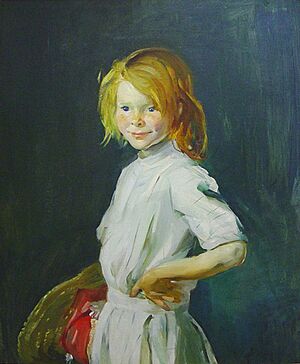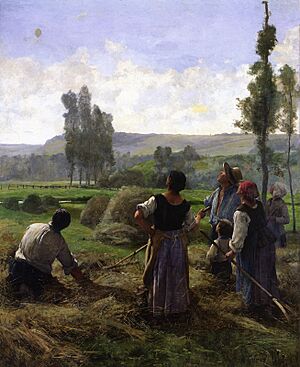Reading Public Museum facts for kids
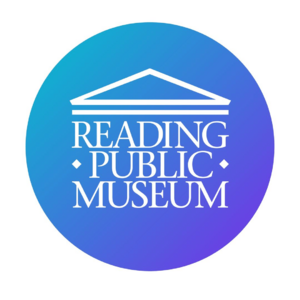 |
|
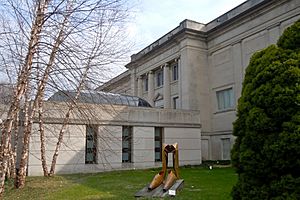
Outside view
|
|
| Location | West Reading, Pennsylvania |
|---|---|
The Reading Public Museum is a cool place to visit in Reading, Pennsylvania. It's located in the 18th Ward, right next to the Wyomissing Creek. This museum is packed with amazing things! It has over 280,000 objects in its main collection. These items cover art, science, and civilization. The museum also has a special planetarium called the Neag Planetarium. Plus, there's a huge 25-acre (about 100,000 square meters) arboretum outside. An arboretum is like a park with many different kinds of trees and plants.
Contents
Discovering the Museum's History
The Reading Public Museum started way back in 1904. The local school board decided to buy some exhibits from the Louisiana Purchase Exposition, also known as the Saint Louis World's Fair. These new items were added to the private collections of Dr. Levi Walter Mengel, who loved natural history.
How It All Began
The museum first opened its doors to everyone in 1913. It was located in an old school building on Washington and Eighth streets. In that same year, the museum began collecting works of art. Dr. Levi Mengel was a very important person for the museum. He was its first director and is known as its founding father. Christopher Shearer, a famous landscape artist, became the museum's first art curator.
A New Home for the Collections
Work began on the museum's current building in February 1925. The first stone was laid on May 1, 1925. By 1928, the museum was open to the public in its beautiful new home. The building was designed in a style called Beaux-Art by Alexander Forbes Smith. Later, in 1998, architect Der Scutt added a modern glass entrance to the building. The large arboretum outside was planned in the late 1920s by a famous landscape architect named John Nolen. Since 1991, a group called The Foundation for the Reading Public Museum has been in charge of running the museum. The museum has been officially recognized by the American Alliance of Museums since 1982.
Amazing Collections to Explore
The Reading Public Museum has many different types of collections. Its art collection is very strong, especially with American artworks.
Art from Around the World
The museum's fine art collection includes more than 700 oil paintings. These paintings are by artists from America and other countries. You can see works by famous American artists like Benjamin West, Gilbert Stuart, John Singer Sargent, and N. C. Wyeth. There are also paintings by modern American artists such as Milton Avery and Alexander Calder.
The museum also has European paintings by artists like Edgar Degas and Julien Dupre. You can also find sculptures by well-known artists such as Auguste Rodin and Henry Moore.
Works on Paper and Photographs
The museum holds over 12,000 works on paper. This includes everything from old illuminated manuscripts to prints by modern artists like Andy Warhol and Keith Haring. There are also many photographs by important photographers such as Ansel Adams and Dorothea Lange.
Ancient Worlds and Armor
One of the most exciting parts of the ancient collection is Nefrina, a real mummy from ancient Egypt! She lived during the Ptolemaic period. The museum also has a great collection of ancient Greek vases and Roman marble sculptures.
In the Arms and Armor gallery, you can see amazing European armor from the 1500s and 1600s. This includes a special suit of armor called a Maximilian suit. There are also examples of armor and weapons from Japan, the Islamic world, Africa, and the South Pacific.
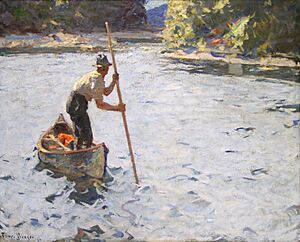
Cultures and History
The museum has hundreds of historic artworks from different North American Indian peoples. These include items from the Lenape, Inuit, Blackfoot, and Sioux, among many others. You can also explore Asian collections with art from China, Japan, India, and Thailand.
There's a large collection of objects from the Pennsylvania Dutch (also known as Pennsylvania German) culture. These include colorful folk art called fraktur, painted furniture, and old clocks. The museum has special galleries for American Art, Modern and Contemporary Art, European Art, and the arts of North American Indians. There are also sections for Ancient Civilizations, Arts of the Ancient Americas, and Natural History.
Natural Wonders
The museum's natural history collections are huge! They include thousands of moths and butterflies, many collected by Levi W. S. Mengel himself. You can also see other insects, birds, nests, bird eggs, mammals, fossils, minerals, and different plant specimens.
See also


